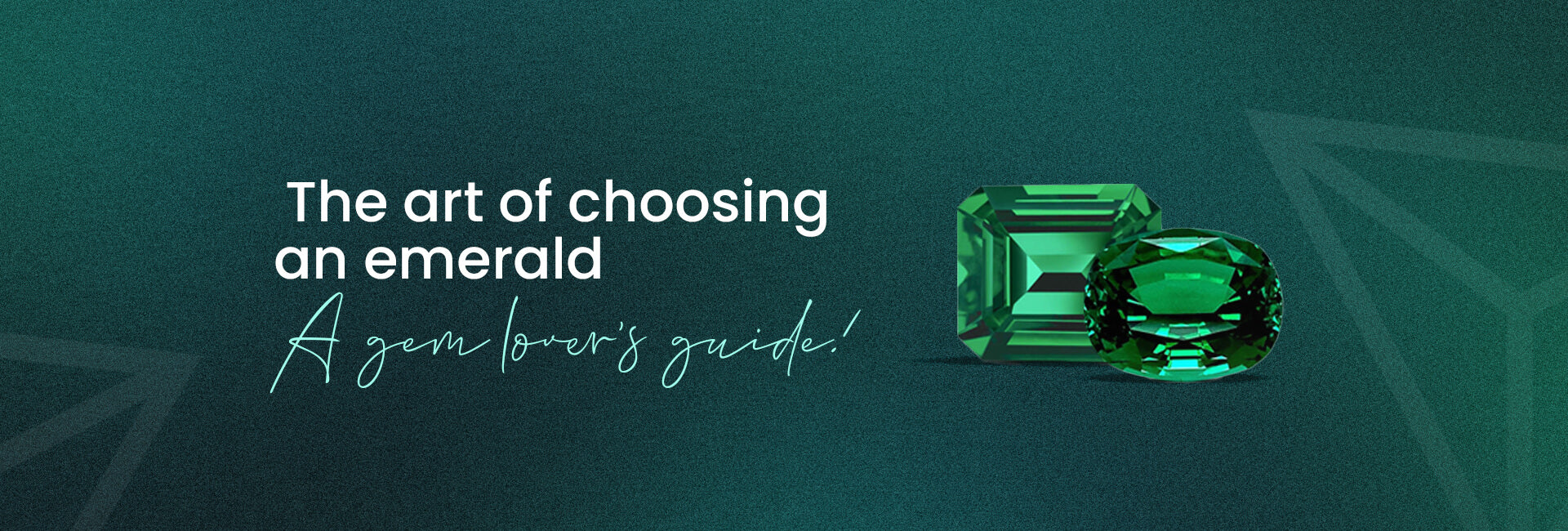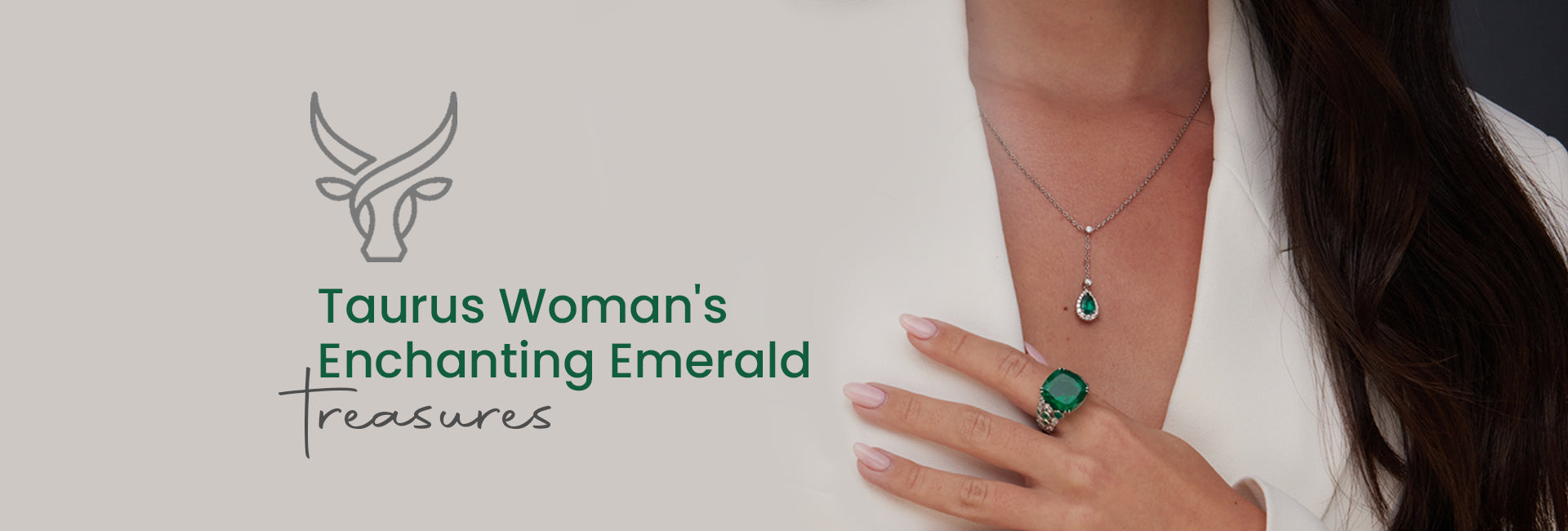
The Art of Choosing an Emerald: A Gem Lover's Guide!
Selecting the finest natural emerald stone is a skill, and if you know how to do it, you too may be a master of the arts. Because a gemstone is made up of several different natural components, it is important to keep in mind that everything natural will have imperfections. Thus, keep the following advice in mind the next time you purchase an emerald to be sure you are making the appropriate investment.
1. Colour is Key: Emerald gemstones are very sought-after because of their brilliant green tinge, which largely determines their value. Look for emeralds that have a deep, rich green colour, sometimes called "emerald green." A striking hue that has faint overtones of brown or yellow highlights the gem's beauty.
- Hue: Green is the primary hue of an emerald. Emeralds may exhibit secondary hues like blue or yellow even within the green colour range. The most valuable emeralds frequently have little to no extra colour and a strong green tinge.
- Saturation: Saturation is the degree to which the green colour of an emerald is intense or vibrant. The most beautiful and distinctive green is the one that enhances the stone's beauty and individuality. Dull or overly dark emeralds could lack the vibrancy that gives emerald gemstones their allure.
- Tone: An emerald tone describes the brightness or darkness of the hue green. The best tone for emeralds is medium to medium dark. Too dark stones can lose their brilliance, while too light stones may appear washed out.
- Colour Zoning: The term "colour zoning" describes the unequal dispersion of hue inside the gemstone. Emeralds should ideally have a uniform, even hue throughout. Distinct colour zones or an uneven hue distribution might detract from the stone's overall beauty.
2. Examine the Cut: Emerald cut is essential to bringing out the colour and sparkle of the stone. Rectangular and square forms are used in traditional emerald cuts, which highlight the colour of the stone. But rather than concentrating on increasing carat weight, the cut should highlight the stone's inherent beauty. An emerald with excellent cutting will have a lovely harmony of depth and brilliance.
- Shape: Emeralds are usually cut into square or rectangular shapes to preserve carat weight and bring out the colour of the stone. The conventional emerald cut has an exquisite and timeless look because of its step-cut facets and cropped corners. The more popular shapes are oval, pear, and round, and each has special qualities of its own.
- Proportions: The length-to-width ratio of an emerald is one of its most significant proportional attributes. Properly proportioned emeralds have balanced dimensions that enhance their beauty. Oversized pieces might take away from the stone's brilliance and make it look unsightly.
- Brilliance and Transparency: A well-cut emerald should have a pleasing balance of brilliance and clarity. The stone should be able to allow light to pass through the cut, enhancing its natural beauty and colour. A well-cut stone can also aid in hiding inclusions, enhancing the clarity of the emerald as a whole.
3. Clarity Matters: Unlike diamonds, emeralds usually have inclusions, which are intrinsic defects in the stone. These inclusions are known as "jardin" (French for garden), because they are an inherent feature of the stone. On the other hand, too many inclusions might weaken the stone's durability. When choosing an emerald, try to strike a balance between clarity and character, being careful that the inclusions don't compromise the gem's structural integrity.
- Type of Inclusions: Emeralds may include a variety of inclusions, including fractures, gas bubbles, and mineral crystals. Some imperfections are more acceptable than others, and their influence on the stone's appearance might vary. For example, minor adjustments that don't significantly change transparency could be approved.
- Transparency: Transparency is crucial when evaluating the overall quality of an emerald. Transparent emeralds are uncommon, but typically more costly. The brilliance and allure of the stone may be diminished by impurities that compromise transparency. Finding a balance is important, though, because emeralds are rarely completely transparent.
- Balance of Inclusions: Although few inclusions are usually desirable, some inclusions may give an emerald more character, giving each stone a distinct appearance. The ideal amount of inclusions is crucial to avoid detracting from the stone's overall beauty.
4. Carat Weight and Size: Although an emerald's carat weight plays a role in determining its value, colour, cut, and clarity should always come first. A finer, smaller emerald might be just as beautiful, even if larger emeralds are more costly since they are rarer. Consider your budget as well as your personal preferences when selecting the right carat weight for your emerald.
5. Treatment Disclosure: Emeralds are frequently treated to improve their colour and clarity. It's important to find out about any treatments the emerald may have had and make sure the vendor gives you complete information. Oiling is a common treatment that improves clarity by filling cracks that reach the surface. You can determine the stone's genuine worth and make an informed purchase by being aware of the treatment history.
6. Choose the Right Setting: Your emerald's setting may have a big impact on how it looks overall. Consider selecting a setting that brings out the colour of the stone and allows light to catch its brightness. White gold can accentuate the green tones of emeralds, while yellow gold can provide a cosy, conventional feel.
Choosing the perfect emerald is an enjoyable process that combines gemology knowledge with personal taste. You can make an informed decision by considering factors including colour, cut, clarity, carat weight, treatment disclosure, and the right setting. Whether you're picking an emerald for an engagement ring, a necklace, or a pair of earrings, these tips can help you select one that celebrates the timeless beauty of emeralds and reflects your taste.


